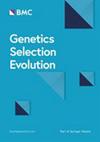Positive selection on rare variants of IGF1R and BRD4 underlying the cold adaptation of wild boar
IF 3.1
1区 农林科学
Q1 AGRICULTURE, DAIRY & ANIMAL SCIENCE
引用次数: 0
Abstract
Domestic piglets often die of hypothermia, whereas Eurasian wild boar (Sus scrofa) thrives from tropical lowlands to subarctic forests. The thermoregulation of wild boar offers a natural experiment to uncover the genetic basis of cold adaptation. We conducted whole-genome resequencing on wild populations from cold regions (northern and northeastern Asia, with six samples) and warm regions (southeastern Asia and southern China, with five samples). By integrating publicly available data, we compiled a core dataset of 48 wild boar samples and an extended dataset of 445 wild boar and domestic pig samples to identify candidate genes related to cold adaptation. To investigate the functional effects of two candidate variants under positive selection, we performed CUT&Tag and RNA-seq using the northeastern Asian Min pig breed as a proxy for a cold-adapted population. Our study identified candidate genes associated with cold adaptation, which are significantly enriched in thermogenesis, fat cell development, and adipose tissue pathways. We discovered two enhancer variants under positive selection: an intronic variant of IGF1R (rs341219502) and an exonic variant of BRD4 (rs327139795). These variants exhibited the highest differentiation between populations of wild boar and domestic pigs in cold and warm region populations. Furthermore, these rare variants were absent in outgroup species and warm-region wild boars but were nearly fixed in cold-region populations. The H3K27ac CUT&Tag profiling revealed that the rs341219502 variant of IGF1R is linked to the gain of novel binding sites for three transcription factors involving regulatory changes in enhancer function. In contrast, the rs327139795 variant of BRD4 may result in the loss of a phosphorylation site due to an alteration in the amino acid sequence. Our study identified candidate genes for cold adaptation in wild boar. The variant rs341219502 in the IGF1R enhancer and the variant rs327139795 in the BRD4 exon, both of which were under positive selection and nearly fixed in populations from cold regions, suggest they may have originated de novo in these populations. Further analysis indicated that rs341219502 could influence enhancer function, while rs327139795 may affect amino acid alterations. Overall, our study highlights the adaptive evolution of genomic molecules that contribute to the remarkable environmental flexibility of wild boar.IGF1R和BRD4罕见变异的正选择是野猪冷适应的基础
国内仔猪经常死于体温过低,而欧亚野猪(Sus scrofa)在热带低地到亚北极森林中茁壮成长。野猪的体温调节为揭示寒冷适应的遗传基础提供了一个自然实验。我们对来自寒冷地区(亚洲北部和东北部,6个样本)和温暖地区(东南亚和中国南部,5个样本)的野生种群进行了全基因组重测序。通过整合公开数据,我们构建了48个野猪样本的核心数据集和445个野猪和家猪样本的扩展数据集,以确定与冷适应相关的候选基因。为了研究两个候选变异在正选择下的功能影响,我们使用东北亚Min猪品种作为冷适应群体的代理,进行了CUT&Tag和RNA-seq。我们的研究确定了与冷适应相关的候选基因,这些基因在产热、脂肪细胞发育和脂肪组织途径中显著富集。我们在正选择下发现了两个增强子变体:IGF1R的内含子变体(rs341219502)和BRD4的外显子变体(rs327139795)。这些变异在寒冷和温暖地区的野猪和家猪群体之间表现出最高的分化。此外,这些罕见的变异在群外物种和温暖地区的野猪中不存在,但在寒冷地区的种群中几乎是固定的。H3K27ac CUT&Tag分析显示,IGF1R的rs341219502变体与三种转录因子的新结合位点的获得有关,这些转录因子涉及增强子功能的调节变化。相比之下,BRD4的rs327139795变体可能由于氨基酸序列的改变而导致磷酸化位点的丢失。本研究确定了野猪冷适应的候选基因。IGF1R增强子中的变异rs341219502和BRD4外显子中的变异rs327139795,两者都处于正选择下,并且在寒冷地区的人群中几乎是固定的,这表明它们可能是在这些人群中重新产生的。进一步分析表明rs341219502可能影响增强子功能,而rs327139795可能影响氨基酸改变。总的来说,我们的研究强调了基因组分子的适应性进化,这有助于野猪显著的环境灵活性。
本文章由计算机程序翻译,如有差异,请以英文原文为准。
求助全文
约1分钟内获得全文
求助全文
来源期刊

Genetics Selection Evolution
生物-奶制品与动物科学
CiteScore
6.50
自引率
9.80%
发文量
74
审稿时长
1 months
期刊介绍:
Genetics Selection Evolution invites basic, applied and methodological content that will aid the current understanding and the utilization of genetic variability in domestic animal species. Although the focus is on domestic animal species, research on other species is invited if it contributes to the understanding of the use of genetic variability in domestic animals. Genetics Selection Evolution publishes results from all levels of study, from the gene to the quantitative trait, from the individual to the population, the breed or the species. Contributions concerning both the biological approach, from molecular genetics to quantitative genetics, as well as the mathematical approach, from population genetics to statistics, are welcome. Specific areas of interest include but are not limited to: gene and QTL identification, mapping and characterization, analysis of new phenotypes, high-throughput SNP data analysis, functional genomics, cytogenetics, genetic diversity of populations and breeds, genetic evaluation, applied and experimental selection, genomic selection, selection efficiency, and statistical methodology for the genetic analysis of phenotypes with quantitative and mixed inheritance.
 求助内容:
求助内容: 应助结果提醒方式:
应助结果提醒方式:


